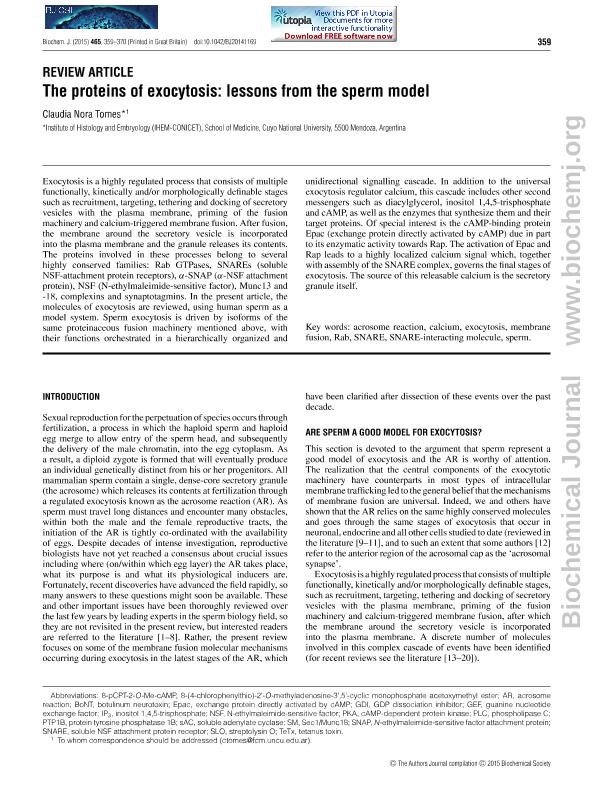Artículo
The proteins of exocytosis: Lessons from the sperm model
Fecha de publicación:
02/2015
Editorial:
Portland Press
Revista:
Biochemical Journal
ISSN:
0264-6021
Idioma:
Inglés
Tipo de recurso:
Artículo publicado
Clasificación temática:
Resumen
Exocytosis is a highly regulated process that consists of multiple functionally, kinetically and/or morphologically definable stages such as recruitment, targeting, tethering and docking of secretory vesicles with the plasma membrane, priming of the fusion machinery and calcium-triggered membrane fusion. After fusion, the membrane around the secretory vesicle is incorporated into the plasma membrane and the granule releases its contents. The proteins involved in these processes belong to several highly conserved families: Rab GTPases, SNAREs (soluble NSF-attachment protein receptors), α-SNAP (α-NSF attachment protein), NSF (N-ethylmaleimide-sensitive factor), Munc13 and -18, complexins and synaptotagmins. In the present article, the molecules of exocytosis are reviewed, using human sperm as a model system. Sperm exocytosis is driven by isoforms of the same proteinaceous fusion machinery mentioned above, with their functions orchestrated in a hierarchically organized and unidirectional signalling cascade. In addition to the universal exocytosis regulator calcium, this cascade includes other second messengers such as diacylglycerol, inositol 1,4,5-trisphosphate and cAMP, as well as the enzymes that synthesize them and their target proteins. Of special interest is the cAMP-binding protein Epac (exchange protein directly activated by cAMP) due in part to its enzymatic activity towards Rap. The activation of Epac and Rap leads to a highly localized calcium signal which, together with assembly of the SNARE complex, governs the final stages of exocytosis. The source of this releasable calcium is the secretory granule itself.
Archivos asociados
Licencia
Identificadores
Colecciones
Articulos(IHEM)
Articulos de INST. HISTOLOGIA Y EMBRIOLOGIA DE MEND DR.M.BURGOS
Articulos de INST. HISTOLOGIA Y EMBRIOLOGIA DE MEND DR.M.BURGOS
Citación
Tomes, Claudia Nora; The proteins of exocytosis: Lessons from the sperm model; Portland Press; Biochemical Journal; 465; 2-2015; 359-370
Compartir
Altmétricas




